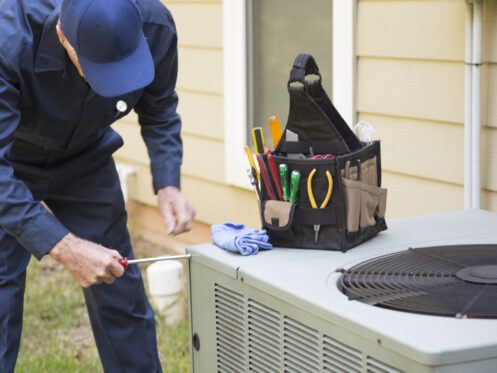The heat of Shreveport summers can be intense, so you need a cooling unit that keeps your home comfortable. Your air conditioner needs proper maintenance to continue running efficiently and safely. We’ll explain why maintenance is so important for your HVAC system and the steps our expert technician will take during the inspection and maintenance appointment.
Why Is Maintenance and Inspection Important?
Your air conditioner is a hardworking machine and is responsible for keeping your home comfortable during the summer heat. Inspection and maintenance are crucial to keep the unit running efficiently and safely. Identifying damaged and worn parts helps you avoid costly emergency repairs down the road and contributes to better working conditions for your unit. The AC is more energy efficient when all components are in top working order.
- Lower risk of breakdowns and failures
- Helps avoid emergency repairs
- Extends the lifespan of your unit
- Provides greater energy efficiency
- Promotes better indoor air quality
Parts of the AC Inspection and Maintenance Checklist
Our trained professionals inspect and assess every detail of your air conditioner. Through this detailed inspection, we ensure your unit is ready to run this summer. Below we’ve listed the major components of your annual AC maintenance and inspection checklist.
Visual Inspection
The first step of annual maintenance is a visual inspection of your unit. The technician looks for signs of damage and excess wear and tear that could cause your machine to malfunction or break down prematurely.
Change the Air Filters
Your HVAC system has air filters that trap dust, dirt, and allergens. This filter keeps these contaminants out of your vents for healthier indoor air. The air filters should be changed every one to three months, and the technician will change them for you if needed.
Clean the Outside of the Unit
Your outdoor unit is open to the elements all year. The AC unit should be wiped down and debris should be removed from the top of it. Your unit should have a clearance of at least two feet on each side.
Clear the Condensate Drain
Condensation is created by your air conditioner when it runs. This condensation becomes water and must move safely away from your air conditioning unit. The condensate drain gives this water a pathway to exit the area without damaging your AC. If this line gets plugged up with debris, the water will be unable to escape. This sitting water could cause operating issues for your AC. The technician will clear debris away from the drain and ensure that it is clear for water to move through.
Inspect Electrical Connections
Electricity is necessary for your air conditioner to run. The technician will assess the wiring and power supply of your AC, ensuring everything is tight and secure. Frayed or damaged wires pose a safety risk with shock, electrocution, and electrical fires as the top concerns. They may also cause your AC to fail. The technician can replace any damaged wires and secure loose connections.
The technician will also test for proper voltage and operating amps during the inspection of the electrical portion of your system. This helps to ensure that your AC is not running too high or too low, causing short circuits, power surges, and other electrical problems.
Check the Refrigerant Level
Your AC requires refrigerant to cool the air that blows through your vents. The technician will check the refrigerant level in your unit and add more as needed. If you are extremely low, there may be a leak in your system. Your technician may look for signs of a leak during the maintenance appointment. Refrigerant should only be handled by a trained professional as there are health hazards associated with exposure.
Lubricate Moving Parts
Some of the parts of your air conditioner move to operate your unit. These parts require lubrication to lessen the impact of friction. Lubrication lowers the risk of excess wear and tear of these parts.
Clean the Coils
Your air conditioner has condenser and evaporator coils inside of it. The coils should be wiped down and cleaned to remove dust and dirt that has settled on them. This cleaning promotes a longer lifespan for your unit and more efficient operation. While cleaning the coils, the technician will also inspect for signs of wear and damage.
Inspect Belts and Pulleys
Some parts of your AC are moved by belts and pulleys. The belts and pulleys should be tight and intact. The technician will look for cracks, loose components, and other signs of damage during this step.
Listen for Strange Noises
While inspecting your AC, the technician will run the unit and listen for any strange noises during operation. The air conditioner should be quiet while it runs, so any loud or banging noises should be investigated.
Check for Odd Smells
As the technician listens for noises, they will also check for odd smells from the unit or your vents. You should not be able to smell anything different while your air conditioner operates.
Check the Blower Motor
A blower motor inside your HVAC unit moves cold air into the ductwork to be dispersed around your house. The technician will visually examine the motor for signs of damage that could hinder proper operation.
Inspect Controls and Assess Safety
Air conditioners have safety controls and functions that stop your unit from operating when conditions are dangerous. Your technician will inspect the unit and test these controls to ensure each of them works as they should. If the AC fails to power off when a malfunction occurs, the unit could be damaged and may cause damage to your home and belongings.
Calibrate the Thermostat
Your thermostat controls the temperature inside your home. With the push of a button, you can adjust the temperature up and down. The temperature inside should match what the thermostat displays. This sends a signal to the AC, telling it when to cycle back on and when to stop. If you have trouble keeping your home comfortable, the technician can check your thermostat to ensure the temperature matches the temperature of the room it is in. If not, it may need calibration.
Most thermostats run on battery power. When the batteries die, you will not be able to control the air conditioner. You can change the batteries yourself as needed, but it may be easier to remember if you do it in conjunction with your annual maintenance.
Annual preventative maintenance ensures your air conditioner is ready and safe to keep you cool throughout the hot summer months. Our expert technicians know all about air conditioners and will provide thorough and detailed maintenance. We also offer repairs and installations as well as service for your furnace. Our company also employs highly skilled plumbers to handle all household plumbing needs, including sump and sewer services. Count on us for all your plumbing and HVAC needs and we’ll ensure you maintain a comfortable and convenient home.
For skilled and thorough air conditioner inspection and maintenance in Shreveport, count on the expert technicians at Bobby L Greene Plumbing, Heating & Cooling Co..

